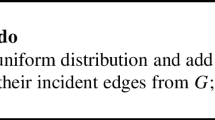Abstract
We consider the cover timeE u [G], the expected time it takes a random walk that starts at vertexu to visit alln vertices of a connected graphG. Aleliunas et al introduced the spanning tree argument: for any spanning treeT of the graphG, E u [G]≤W[T], whereW[T] is the sum of commute times along the edges ofT. By refining the spanning tree argument we obtain:
whereH[u,v] is the hitting time fromu tov. We use this bound to show:
-
1.
max G min u E u [G]=(1+o(1))2n 3/27. This answers an open question of Aldous.
-
2.
Then-path is then-vertex tree on which the cover time is maximized. This confirms a conjecture of Brightwell and Winkler.
-
3.
For regular graphs,E u [G]<2n 2. This improves the leading constant in previously known upper bounds.
We also provide upper bounds onE + u [G], the expected time to coverG and return tou.
Similar content being viewed by others
References
D. Aldous, J. Fill,Reversible Markov chains and random walks on graphs. Book in preparation. Draft available via homepage http://www.stat.berkeley.edu/users/aldous.
R. Aleliunas, R. M. Karp, R. J. Lipton, L. Lovász, C. Rackoff, Random walks, universal traversal sequences, and the complexity of maze problems. InProceedings of the 20th Annual Symposium on Foundations of Computer Science, pages 218–223, San Juan, Puerto Rico, October 1979.
G. Brightwell, P. Winkler, Extremal Cover Times for Random Walks on Trees.Journal of Graph Theory, 14(5):547–554, 1990.
A. Chandra, P. Raghavan, L. Ruzzo, R. Smolensky, P. Tiwari, The electrical resistance of a graph captures its commute and cover times. InProceedings of the 21st Annual ACM Symposium on the Theory of Computing, 1989, 574–586.
D. Coppersmith, U. Feige, J. Shearer, Random Walks on Regular and Irregular Graphs:SIAM J. on Discrete Math., 9(2):301–308, May 1996.
D. Coppersmith, P. Tetali, P. Winkler, Collisions among random walks on a graph.SIAM J. on Discrete Math., 6(3):363–374, August 1993.
P. Doyle, J. Snell,Random walks and electrical networks. The Mathematical Association of America, Washington D.C., 1984.
U. Feige, A Tight Upper Bound on the Cover Time for Random Walks on Graphs.Random Structures and Algorithms, Vol. 6, No. 1 (1995) 51–54.
U. Feige, A Tight Lower Bound on the Cover Time for Random Walks on Graphs.Random Structures and Algorithms, Vol. 6, No. 4 (1995) 433–438.
J. Kemeny and J. Snell,Finite Markov Chains. Springer Verlag, 1983.
P.C. Matthews, Covering Problems for Brownian Motion on Spheres.Ann. Probab., 16:189–199, 1988.
P. Tetali, Random walks and the effective resistance of networks.Journal of Theoretical Probability, 4:101–109, 1991.
P. Tetali, P. Winkler, Simultaneous reversible Markov chains. InCombinatorics, Paul Erdős is Eighty, Vol. 1, Keszthely, Hungary (1993), 433–451.
Author information
Authors and Affiliations
Rights and permissions
About this article
Cite this article
Feige, U. Collecting coupons on trees, and the cover time of random walks. Comput Complexity 6, 341–356 (1996). https://doi.org/10.1007/BF01270386
Received:
Issue Date:
DOI: https://doi.org/10.1007/BF01270386




